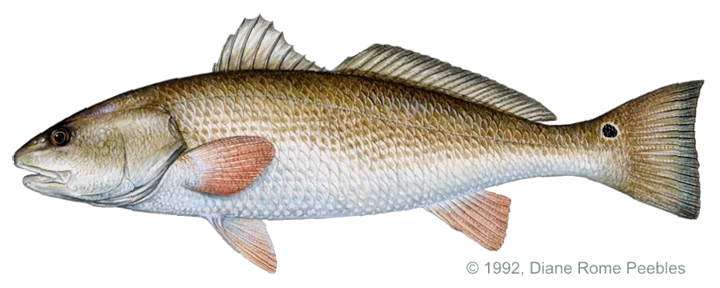Game Fish Identification Reference Guides
Drum, red
(Sciaenops ocellatus)
(Sciaenops ocellatus)

(Linnaeus, 1766); SCIAENIDAE FAMILY; also called channel bass, redfish, spot tail bass, red bass, red horse, school drum, puppy drum
Found in the western Atlantic Ocean from Maine to the Gulf of Mexico. The red rum is a schooling species that occurs inshore over sandy or muddy bottoms. It inhabits both salt and brackish waters and can tolerate fresh water. It is found in inlets and channels, and smaller specimens may be found in shallow estuaries.
The red drum can be distinguished from the black drum (Pogonias cromis) by its lack of chin barbels and more elongated body. The body has coppery red overtones on a silvery gray background. The most obvious and characteristic marking on the red drum is a large black spot about the size of the eye on either side of the caudal peduncle, just before the tail fin. Sometimes there are two spots on each side, and occasionally there may be similar spots on the body.
It is a strong, hard fighter when hooked. Fishing methods include drifting or still fishing on the bottom, jigging or casting from boats or from the shore, and slow trolling. In some areas red drum may be stalked on the flats like bonefish. Baits and lures include crabs, shrimp, clams, jigs, plugs, spoons, strip bait, and streamer flies. Large red drum can be taken from just above the breaker line on an incoming tide or near channels, inlets and shell beds.
Very large specimens are often called “bull reds”, although they are usually females. Red drum up to about 10 15 lb (5 7 kg) are very fine eating. Larger specimen may be coarse, stringy and unpalatable
Found in the western Atlantic Ocean from Maine to the Gulf of Mexico. The red rum is a schooling species that occurs inshore over sandy or muddy bottoms. It inhabits both salt and brackish waters and can tolerate fresh water. It is found in inlets and channels, and smaller specimens may be found in shallow estuaries.
The red drum can be distinguished from the black drum (Pogonias cromis) by its lack of chin barbels and more elongated body. The body has coppery red overtones on a silvery gray background. The most obvious and characteristic marking on the red drum is a large black spot about the size of the eye on either side of the caudal peduncle, just before the tail fin. Sometimes there are two spots on each side, and occasionally there may be similar spots on the body.
It is a strong, hard fighter when hooked. Fishing methods include drifting or still fishing on the bottom, jigging or casting from boats or from the shore, and slow trolling. In some areas red drum may be stalked on the flats like bonefish. Baits and lures include crabs, shrimp, clams, jigs, plugs, spoons, strip bait, and streamer flies. Large red drum can be taken from just above the breaker line on an incoming tide or near channels, inlets and shell beds.
Very large specimens are often called “bull reds”, although they are usually females. Red drum up to about 10 15 lb (5 7 kg) are very fine eating. Larger specimen may be coarse, stringy and unpalatable












